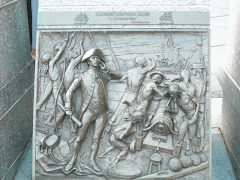The first figure of the article shows the temperature measured at the surface of the Sargasso Sea, which is a large area of the Atlantic, over a 3,000 year period using isotope ratios of marine organisms left in the sediment. The average temperature of this period is drawn as a reference and it is seen that the height of Greek civilization occurred during a warm period with a maximum temperature about 2 degrees Centigrade warmer than the average temperature, that the Roman period corresponded to a temperature period very near average, that the Fall of Rome and the Dark Ages corresponded to a period in which the temperature dropped by about 1 degree Centigrade, followed by the Medival Climate Optimum during which conditions improved in Europe, followed again by a decrease called the Little Ice Age, followed again by a return to a very nearly average temperature, where we are today. The French and Indian War and the American Revolution were during the coldest parts of the Little Ice Age, with conditions few living Americans would prefer to those of the present near average temperature. This figure is shown below:
 They then show that the shortening of glaciers occurred well before increases in the atmospheric CO2 began. It began as a result of the warming ending the Little Ice Age. They show that the arctic temperature correlates very well back to 1880 with solar activity and does not correlate with atmospheric CO2. Then they show that the increase in annual mean surface temperature in the contiguous United States from 1880 to 2006 was 0.5 degree Centigrade per century. This is a temperature difference well within the 3 degree Centigrade variance over the last 3,000 years and one which few people would notice personally. A 0.5 C temperature increase is caused by an increase in solar activity of about 0.21% and the measured increase in solar activity from 1900 to 2000 was 0.19%.
They then show that the shortening of glaciers occurred well before increases in the atmospheric CO2 began. It began as a result of the warming ending the Little Ice Age. They show that the arctic temperature correlates very well back to 1880 with solar activity and does not correlate with atmospheric CO2. Then they show that the increase in annual mean surface temperature in the contiguous United States from 1880 to 2006 was 0.5 degree Centigrade per century. This is a temperature difference well within the 3 degree Centigrade variance over the last 3,000 years and one which few people would notice personally. A 0.5 C temperature increase is caused by an increase in solar activity of about 0.21% and the measured increase in solar activity from 1900 to 2000 was 0.19%.During the recovery from the Little Ice Age, U.S. climate has improved with more rainfall, fewer tornadoes, and no increase in hurricane activity. Sea level has trended upward over the last 150 years at a rate of 7 inches per century. This sea level rise also began with the end of the Little Ice Age, rather than with the major increases in atmospheric CO2.
During the past 50 years, human use of hydrocarbons has increased 6-fold, but the increase in atmospheric CO2 has been only 22%. This increase in atmospheric CO2 has stimulated plant growth, which is good for both humans and other animals. Higher CO2 concentrations allow plants to grow faster and larger and to grow better in drier climates than otherwise. The Industrial Revolution has not only improved human life, but it has benefited plant life and the animals who depend upon plants. Increased warmth has also made life a bit easier for most plants and animals. The historical record of bursts in human civilizations also seems strongly to correlate with the warmer periods of the last 3,000 years.

































































No comments:
Post a Comment